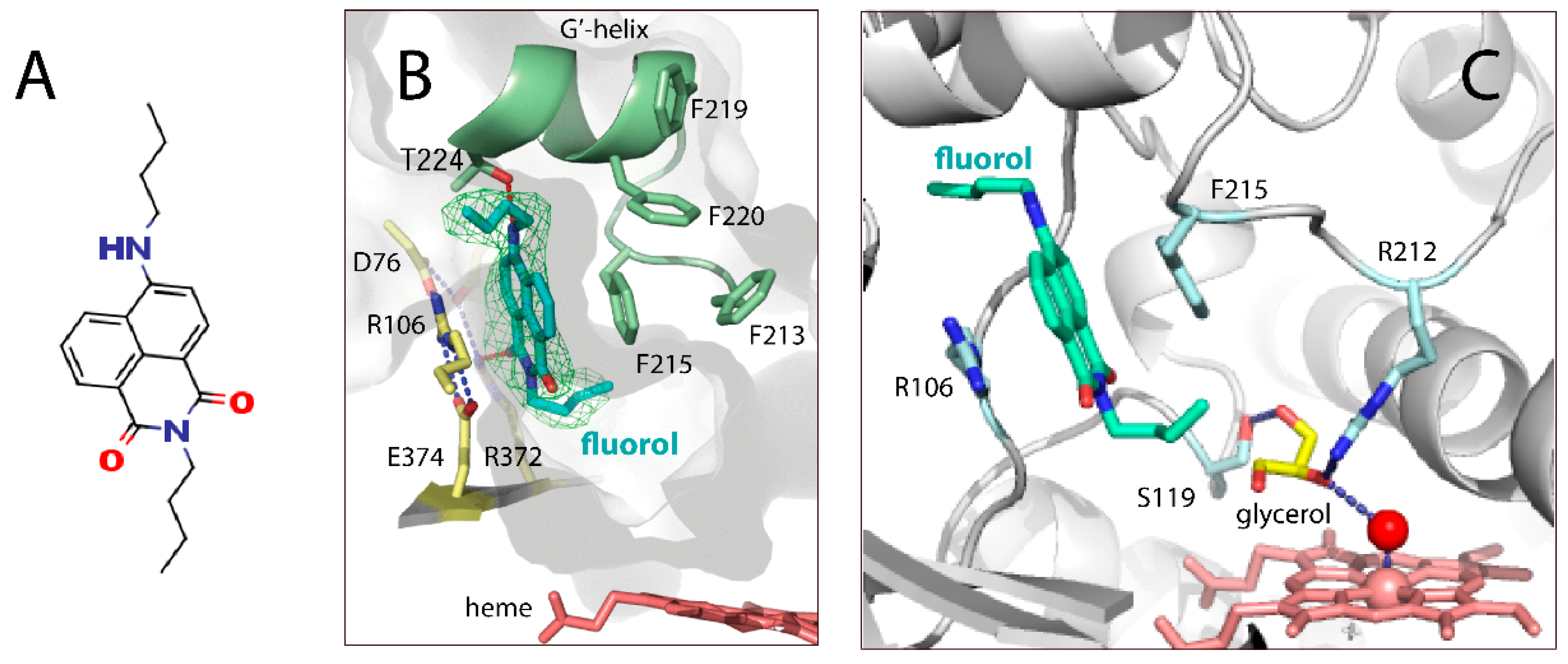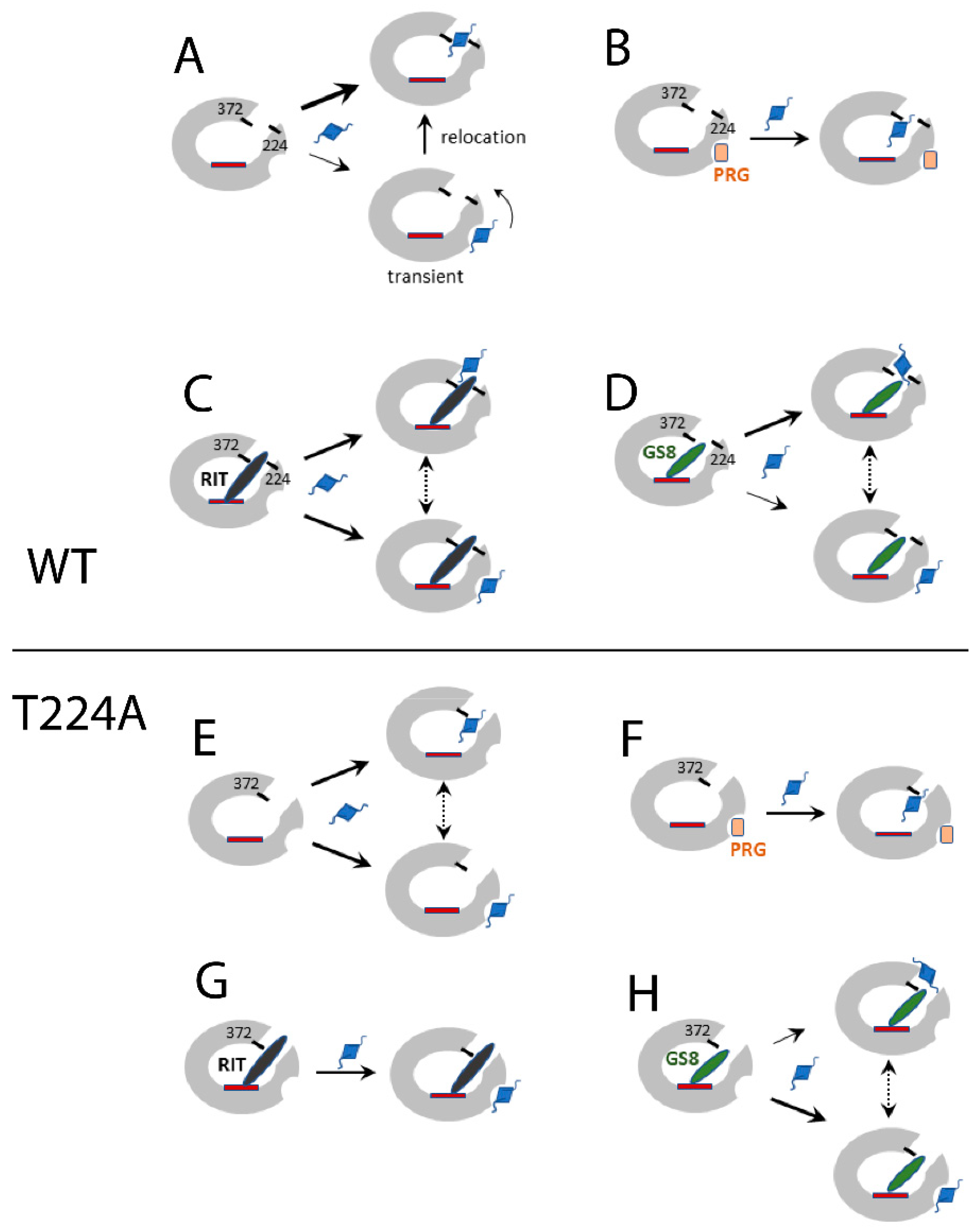Crystal Structure of CYP3A4 Complexed with Fluorol Identifies the Substrate Access Channel as a High-Affinity Ligand Binding Site
Abstract
1. Introduction
2. Results
2.1. Crystal Structure of the CYP3A4–Fluorol Complex
2.2. Effect of the T224A Mutation on Fluorol Association
2.2.1. Spectral Titrations
2.2.2. Fluorescence Titrations
2.2.3. Fluorol Binding Kinetics
2.3. Fluorol Metabolism
3. Discussion
4. Materials and Methods
Supplementary Materials
Funding
Institutional Review Board Statement
Informed Consent Statement
Data Availability Statement
Acknowledgments
Conflicts of Interest
Abbreviations
| CYP3A4 | Cytochrome P450 3A4 |
| BEC | Bromoergocryptine |
| WT | Wildtype |
References
- Guengerich, F.P.; Shimada, T. Oxidation of toxic and carcinogenic chemicals by human cytochrome P-450 enzymes. Chem. Res. Toxicol. 1991, 4, 391–407. [Google Scholar] [CrossRef] [PubMed]
- Li, A.P.; Kaminski, D.L.; Rasmussen, A. Substrates of human hepatic cytochrome P450 3A4. Toxicology 1995, 104, 1–8. [Google Scholar] [CrossRef]
- Guengerich, F.P. Cytochrome P-450 3A4: Regulation and role in drug metabolism. Annu. Rev. Pharmacol. Toxicol. 1999, 39, 1–17. [Google Scholar] [CrossRef]
- Atkins, W.M. Non-Michaelis-Menten kinetics in cytochrome P450-catalyzed reactions. Annu. Rev. Pharmacol. Toxicol. 2005, 45, 291–310. [Google Scholar] [CrossRef] [PubMed]
- Sevrioukova, I.F.; Poulos, T.L. Structural and mechanistic insights into the interaction of cytochrome P4503A4 with bromoergocryptine, a type I ligand. J. Biol. Chem. 2012, 287, 3510–3517. [Google Scholar] [CrossRef] [PubMed]
- Sevrioukova, I.F.; Poulos, T.L. Structural basis for regiospecific midazolam oxidation by human cytochrome P450 3A4. Proc. Natl. Acad. Sci. USA 2017, 114, 486–491. [Google Scholar] [CrossRef]
- Sevrioukova, I.F. Structural insights into the interaction of cytochrome P450 3A4 with suicide substrates: Mibefradil, azamulin and 6′,7′-dihydroxybergamottin. Int. J. Mol. Sci. 2019, 20, 4245. [Google Scholar] [CrossRef]
- Ekroos, M.; Sjogren, T. Structural basis for ligand promiscuity in cytochrome P450 3A4. Proc. Natl. Acad. Sci. USA 2006, 103, 13682–13687. [Google Scholar] [CrossRef]
- Williams, P.A.; Cosme, J.; Vinkovic, D.M.; Ward, A.; Angove, H.C.; Day, P.J.; Vonrhein, C.; Tickle, I.J.; Jhoti, H. Crystal structures of human cytochrome P450 3A4 bound to metyrapone and progesterone. Science 2004, 305, 683–686. [Google Scholar]
- Kapelyukh, Y.; Paine, M.J.; Marechal, J.D.; Sutcliffe, M.J.; Wolf, C.R.; Roberts, G.C. Multiple substrate binding by cytochrome P450 3A4: Estimation of the number of bound substrate molecules. Drug Metab. Dispos. 2008, 36, 2136–2144. [Google Scholar] [CrossRef]
- Davydov, D.R.; Davydova, N.Y.; Halpert, J.R. Allosteric transitions in cytochrome P450eryF explored with pressure-perturbation spectroscopy, lifetime FRET, and a novel fluorescent substrate, Fluorol-7GA. Biochemistry 2008, 47, 11348–11359. [Google Scholar] [CrossRef] [PubMed]
- Davydov, D.R.; Rumfeld, J.A.O.; Sineva, E.V.; Fernando, H.; Davydova, N.Y.; Halpert, J.R. Peripheral ligand binding site in cytochrome P450 3A4 located with fluorescence resonance energy transfer (FRET). J. Biol. Chem. 2012, 287, 6797–6809. [Google Scholar] [CrossRef] [PubMed]
- Polic, V.; Auclair, K. Allosteric activation of cytochrome P450 3A4 via progesterone bioconjugation. Bioconjug. Chem. 2017, 28, 885–889. [Google Scholar] [CrossRef] [PubMed]
- Ducharme, J.; Polic, V.; Auclair, K. A Covalently Attached Progesterone Molecule Outcompetes the Binding of Free Progesterone at an Allosteric Site of Cytochrome P450 3A4. Bioconjug. Chem. 2019, 30, 1629–1635. [Google Scholar] [CrossRef]
- Sevrioukova, I.F.; Poulos, T.L. Dissecting cytochrome P450 3A4-ligand interactions using ritonavir analogues. Biochemistry 2013, 52, 4474–4481. [Google Scholar] [CrossRef]
- Sevrioukova, I.F.; Poulos, T.L. Structure and mechanism of the complex between cytochrome P4503A4 and ritonavir. Proc. Natl. Acad. Sci. USA 2010, 107, 18422–18427. [Google Scholar] [CrossRef]
- Fishelovitch, D.; Shaik, S.; Wolfson, H.J.; Nussinov, R. Theoretical characterization of substrate access/exit channels in the human cytochrome P450 3A4 enzyme: Involvement of phenylalanine residues in the gating mechanism. J. Phys. Chem. B 2009, 113, 13018–13025. [Google Scholar] [CrossRef]
- Yano, J.K.; Wester, M.R.; Schoch, G.A.; Griffin, K.J.; Stout, C.D.; Johnson, E.F. The structure of human microsomal cytochrome P450 3A4 determined by X-ray crystallography to 2.05-A resolution. J. Biol. Chem. 2004, 279, 38091–38094. [Google Scholar] [CrossRef]
- Denisov, I.G.; Grinkova, Y.V.; Nandigrami, P.; Shekhar, M.; Tajkhorshid, E.; Sligar, S.G. Allosteric Interactions in Human Cytochrome P450 CYP3A4: The Role of Phenylalanine 213. Biochemistry 2019, 58, 1411–1422. [Google Scholar] [CrossRef]
- Hackett, J.C. Membrane-embedded substrate recognition by cytochrome P450 3A4. J. Biol. Chem. 2018, 293, 4037–4046. [Google Scholar] [CrossRef]
- Redhair, M.; Hackett, J.C.; Pelletier, R.D.; Atkins, W.M. Dynamics and Location of the Allosteric Midazolam Site in Cytochrome P4503A4 in Lipid Nanodiscs. Biochemistry 2020, 59, 766–779. [Google Scholar] [CrossRef] [PubMed]
- Park, H.; Lee, S.; Suh, J. Structural and dynamical basis of broad substrate specificity, catalytic mechanism, and inhibition of cytochrome P450 3A4. J. Am. Chem. Soc. 2005, 127, 13634–13642. [Google Scholar] [CrossRef] [PubMed]
- Lill, M.A.; Dobler, M.; Vedani, A. Prediction of small-molecule binding to cytochrome P450 3A4: Flexible docking combined with multidimensional QSAR. Chem. Med.Chem. 2006, 1, 73–81. [Google Scholar] [CrossRef] [PubMed]
- Fishelovitch, D.; Hazan, C.; Shaik, S.; Wolfson, H.J.; Nussinov, R. Structural dynamics of the cooperative binding of organic molecules in the human cytochrome P450 3A4. J. Am. Chem. Soc. 2007, 129, 1602–1611. [Google Scholar] [CrossRef] [PubMed]
- Krishnamoorthy, N.; Gajendrarao, P.; Thangapandian, S.; Lee, Y.; Lee, K.W. Probing possible egress channels for multiple ligands in human CYP3A4: A molecular modeling study. J. Mol. Model. 2009, 16, 607–614. [Google Scholar] [CrossRef] [PubMed]
- Du, H.; Li, J.; Cai, Y.; Zhang, H.; Liu, G.; Tang, Y.; Li, W. Computational Investigation of Ligand Binding to the Peripheral Site in CYP3A4: Conformational Dynamics and Inhibitor Discovery. J. Chem. Inf. Model. 2017, 57, 616–626. [Google Scholar] [CrossRef]
- Nair, P.C.; McKinnon, R.A.; Miners, J.O. Computational Prediction of the Site(s) of Metabolism and Binding Modes of Protein Kinase Inhibitors Metabolized by CYP3A4. Drug Metab. Dispos. 2019, 47, 616–631. [Google Scholar] [CrossRef]
- Samuels, E.R.; Sevrioukova, I.F. Interaction of CYP3A4 with Rationally Designed Ritonavir Analogues: Impact of Steric Constraints Imposed on the Heme-Ligating Group and the End-Pyridine Attachment. Int. J. Mol. Sci. 2022, 23, 7291. [Google Scholar] [CrossRef]
- Sevrioukova, I.F. High-level production and properties of the cysteine-depleted cytochrome P450 3A4. Biochemistry 2017, 56, 3058–3067. [Google Scholar] [CrossRef]
- Samuels, E.R.; Sevrioukova, I.F. Rational Design of CYP3A4 Inhibitors: A One-Atom Linker Elongation in Ritonavir-Like Compounds Leads to a Marked Improvement in the Binding Strength. Int. J. Mol. Sci. 2021, 22, 852. [Google Scholar] [CrossRef]
- Brackman, U. Lambdachrome Laser Dyes; Lambda Physik GmbH: Goettingen, Germany, 2000. [Google Scholar]
- McCoy, A.J.; Grosse-Kunstleve, R.W.; Adams, P.D.; Winn, M.D.; Storoni, L.C.; Read, R.J. Phaser crystallographic software. J. Appl. Crystallogr. 2007, 40, 658–674. [Google Scholar] [CrossRef] [PubMed]
- Adams, P.D.; Afonine, P.V.; Bunkoczi, G.; Chen, V.B.; Davis, I.W.; Echols, N.; Headd, J.J.; Hung, L.W.; Kapral, G.J.; Grosse-Kunstleve, R.W.; et al. PHENIX: A comprehensive Python-based system for macromolecular structure solution. Acta Crystallogr. Sect. D 2010, 66, 213–321. [Google Scholar] [CrossRef] [PubMed]
- Emsley, P.; Lohkamp, B.; Scott, W.G.; Cowtan, K. Features and development of Coot. Acta Crystallogr. Sect. D 2010, 66, 486–501. [Google Scholar] [CrossRef] [PubMed]








| Data Statistics | |
|---|---|
| Space group | I222 |
| Unit cell parameters | a = 78 Å, b = 101 Å, c = 130 Å; α, β, γ = 90 |
| Molecules per asymmetric unit | 1 |
| Resolution range (Å) | 71.91–2.40 (2.53–2.40) a |
| Total reflections | 90,908 (13,973) |
| Unique reflections | 20,233 (2963) |
| Redundancy | 4.5 (4.7) |
| Completeness | 98.8 (99.7) |
| Average I/σI | 7.6 (1.1) |
| Rpim | 0.042 (0.878) |
| CC ½ | 0.998 (0.362) |
| Refinement statistics | |
| R/Rfreeb | 18.4/24.6 |
| Number of atoms: | |
| Protein | 3734 |
| Solvent | 6 |
| R.m.s. deviations: | |
| Bond lengths, Å | 0.013 |
| Bond angles, ° | 1.743 |
| Wilson B-factor, Å2 | 67 |
| Average B-factor, Å2: | |
| Protein | 85 |
| Ligand | 94 |
| Solvent | 68 |
| Ramachandran plot c (residues; %) | |
| Preferred | 436 (95%) |
| Allowed | 23 (5%) |
| Outliers | 0 |
| Kd, μM | ||
|---|---|---|
| Spectrophotometric a | Fluorometric b | |
| WT CYP3A4 | ||
| Free | 0.50 ± 0.04 c (28%) e | 0.15 ± 0.03 (25%) |
| 4.2 ± 0.5 d | 2.4 ± 0.4 | |
| 20 μM PRG | ND f | 2.4 ± 0.2 |
| 0.4 μM RIT | ND | 4.8 ± 0.6 |
| 0.4 μM GS8 | ND | 2.1 ± 0.3 |
| T224A CYP3A4 | ||
| Free | 0.67 ± 0.12 (14%) | 2.0 ± 0.3 |
| 6.6 ± 0.8 | ||
| 20 μM PRG | ND | 1.8 ± 0.2 |
| 0.4 μM RIT | ND | 3.5 ± 0.3 |
| 0.4 μM GS8 | ND | 1.6 ± 0.2 |
Publisher’s Note: MDPI stays neutral with regard to jurisdictional claims in published maps and institutional affiliations. |
© 2022 by the author. Licensee MDPI, Basel, Switzerland. This article is an open access article distributed under the terms and conditions of the Creative Commons Attribution (CC BY) license (https://creativecommons.org/licenses/by/4.0/).
Share and Cite
Sevrioukova, I.F. Crystal Structure of CYP3A4 Complexed with Fluorol Identifies the Substrate Access Channel as a High-Affinity Ligand Binding Site. Int. J. Mol. Sci. 2022, 23, 12591. https://doi.org/10.3390/ijms232012591
Sevrioukova IF. Crystal Structure of CYP3A4 Complexed with Fluorol Identifies the Substrate Access Channel as a High-Affinity Ligand Binding Site. International Journal of Molecular Sciences. 2022; 23(20):12591. https://doi.org/10.3390/ijms232012591
Chicago/Turabian StyleSevrioukova, Irina F. 2022. "Crystal Structure of CYP3A4 Complexed with Fluorol Identifies the Substrate Access Channel as a High-Affinity Ligand Binding Site" International Journal of Molecular Sciences 23, no. 20: 12591. https://doi.org/10.3390/ijms232012591
APA StyleSevrioukova, I. F. (2022). Crystal Structure of CYP3A4 Complexed with Fluorol Identifies the Substrate Access Channel as a High-Affinity Ligand Binding Site. International Journal of Molecular Sciences, 23(20), 12591. https://doi.org/10.3390/ijms232012591






